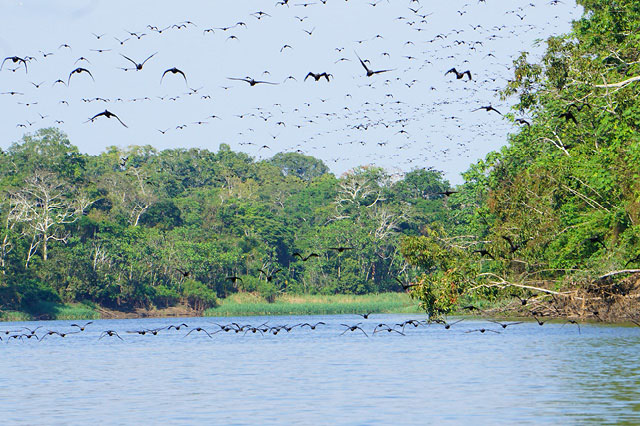A moment ago, the sky was filled with birds, but now my vantage from Parque del Amor (Park of Love) in Lima, Peru, is of a trio of paragliders hanging between the clouds above and the Pacific Ocean below.
Everyone in the park has stopped taking photos of a giant statue of lovers embracing to watch the parachutes fill with the thermal winds rising off the oceanside cliffs. In the hush of awe brought on by these flying men, I can hear the wind whistling through the lines tethering them to their parachutes.
Earlier this week I was on the Amazon River, zipping along in a swift river skiff in search of birds on a pond filled with lily pads the size of dinner tables. We rounded a bend to find what looked like a thousand cormorants flying our way. With their wingtips just inches from the river, lines of them flapped toward us, parting to make room for our boat. As on the cliff in Lima’s Miraflores district, a hush fell over our boat. The only sound was the subtle beat of wings amplified exponentially to make a sound like wet snow falling on wet snow.
Peru is a feast for the senses. From the massive and metropolitan capital of Lima to the jungles of the Amazon, I was awed by the variety and intensity of the country.
On the Amazon, the crew of the Delfin III led jungle hikes and took us piranha fishing. Birds – red crested and yellow bellied and boasting flashes of teal and jade feathers – called to our boat from the trees while monkeys lazed in the branches. When a pink river dolphin surfaced, my guide said, “It’s OK to swim here. The dolphin, he keeps the bad fish away.” I jumped into the black water.
Lima provides a stark urban contrast to the nature and wonder of the Amazon. It’s full of Spanish architecture and colonial churches, shopping districts catering to wealthy Limenos and simple markets filled with produce and fish. I find myself at one such market in San Isidro on my first morning in the city, eating fresh cebiche (the citrus-cooked fish dish we call ceviche; Peru claims it’s the birthplace of the dish). That evening I find myself eating more cebiche, along with cuy – guinea pig – accompanied by inventive revisions of the pisco sour at Astrid y Gabor, a ritzy restaurant named one of the 50 best in the world.
That afternoon, I walked through Miraflores, visiting churches and shops, picking up spices in an open-air market, and finding my way to Parque del Oliver where nearly 1,700 olive trees stand in neat rows and hold prominent places in the yards and gardens nearby. The park and grove date back to 1560 and tie Lima’s past to the present. In a way, the light here and the scent of the blossoms mirror two very different sides of the country: Lima’s cathedrals with their stained glass and smoldering incense, and the Amazon River, where soccer-ball-size flowers on the lily pads perfume the air with a heady scent.















